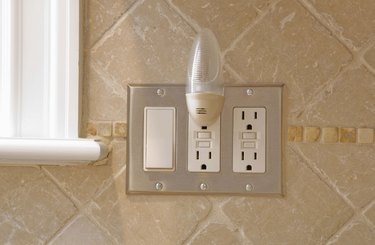 The buttons on these outlets indicate they are GFCI outlets, required in kitchens. Image Credit: Jupiterimages/Creatas/Getty Images
The buttons on these outlets indicate they are GFCI outlets, required in kitchens. Image Credit: Jupiterimages/Creatas/Getty Images
Your kitchen is a power fiend. Just think of all the electrical appliances you use in the kitchen and the fact that each of these requires an outlet to supply electricity. To ensure that your kitchen is safe, you must follow electrical codes for placement and types of outlets. While putting outlets in and around cabinets in your kitchen is one way to hide them from view, you cannot do that with every outlet.
Video of the Day
Kitchen Outlet Requirements
Kitchens need to have outlets placed at regular intervals along the counters. These outlets must be every 4 feet along the counter or 12 feet along a wall. If you install your outlets inside the kitchen cabinets or behind a drop-down appliance garage, they do not count for this spacing requirement, according to the book "NFPA's Residential Wiring." Cabinet outlets should be used as additional power sources to plug in mounted appliances, like above-the-range microwaves or vents.
Outlets Inside Upper Cabinets
Installing some outlets inside cabinets can be done in the kitchen. These outlets are not considered accessible when counting the accessible outlets in your kitchen, but they are safer to use in homes with small children who cannot reach inside the cabinets. The cabinet under the sink should have an outlet for the garbage disposal or dishwasher, and cabinets above and next to a range need an outlet to power a microwave. Check with local building and electrical codes. These cabinet outlets, depending on what they run, might need to be installed on a separate circuit from the other outlets in your kitchen.
Outlets Under Cabinets
To make outlets along the counters less conspicuous but still accessible, install outlets just under the "apron" of raised kitchen cabinets. The apron is the wooden piece that surrounds the base of a cabinet, creating a shallow area inside. Under-cabinet lights or power outlets can be installed in these spots.
GFCI Outlets
In the kitchen, you need to install GFCI outlets for every accessible outlet. These include the outlets serving the counters, whether they are installed under a cabinet or on the wall between the counter and cabinets. Outlets installed inside the cabinets and those hidden behind large appliances, like refrigerators, do not need GFCI outlets. These outlets are designed to shut off the power if something goes wrong with the current, preventing you from getting shocked. They are usually needed in areas like the kitchen, where the outlet might get wet.



























